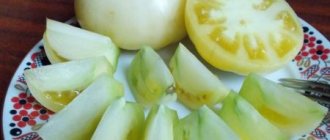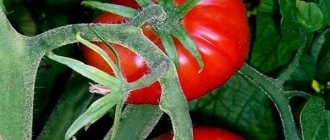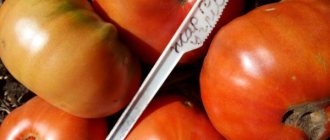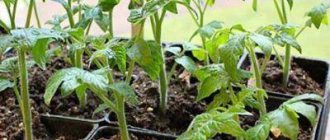Brief description of the variety
Hybrid Incas has standard characteristics. The ripening period of tomatoes is mid-early. From planting seeds to harvesting fruits - approximately 95 - 100 days. The leaves are medium-sized, dark green, without an articulated stalk. The plant forms into a compact bush of 3-4 stems about 100 cm high, then growth is limited. It feels great in a greenhouse or in film shelters, but is also suitable for growing in open ground and tolerates low temperatures well.
The seeds do not need to be soaked before planting, as producers pre-treat them with thiram.
Productivity, characteristics and description of the Alaska tomato variety
The Alaska tomato is ideal for growing without seedlings in risky farming areas. A detailed description of tomatoes can be found on special websites on the Internet or in encyclopedias for gardeners. The variety in question is suitable for both open ground and greenhouse conditions. Alaska tomatoes are an excellent option for regions with short and cold summers.
About the variety
The variety is early ripening (85-100 days) and high-yielding. The fruits begin to ripen at the end of June. "Alaska" is considered determinate, that is, it has limited stem growth. A bush about 0.5 meters high needs tying to a support and moderate pinching. The first inflorescence is formed above the 8-9 leaf, the subsequent ones - every 1-2 leaves. Number of nests – 3-4. No molding is required when growing. The yield of the variety is 2 kg per bush (with proper agricultural technology).
Fruit characteristics
The fruits of "Alaska" are smooth, deep red, flat-round, weighing no more than 100 grams. Their main feature is that they quickly gain sweetness. Juicy and very tasty, they are perfect for both fresh consumption and home canning.
- Easy care;
- Unpretentiousness to weather conditions;
- Resistance to diseases (including tobacco mosaic virus) and fusarium wilt;
- Good fruit set even in cold climates;
- Early and friendly harvest;
- Fruit evenness;
- This tomato can even be grown on a balcony or windowsill.
Landing
It is best to sow seeds between March 20 and March 30. As numerous reviews indicate, germination rates are very high. Picking should be done when the seedlings have 1-2 true leaves. Seedlings should be planted from May 15 - in greenhouses or other shelters, and from May 25 - in open ground. The description of the sowing scheme for Inkas F1 tomatoes is standard: between plants it is necessary to leave from 30 to 40 cm, between the rows there must be at least 50-60 cm. 7-9 plants can be planted on 1 square meter.
To plant Incas F1 tomatoes, it is better to choose a place where cucumbers, cauliflower, parsley, zucchini or dill were grown before them. Incas grows well on sandy and light loamy soils, generously flavored with humus and humus.
How to grow tomatoes
The seedlings are ready for transplanting in mid-May in greenhouse conditions, and in open ground at the end of May. By this time, at least 5-7 true leaves and already fully formed strong roots appear on the bushes.
Landing
The soil for tomatoes is prepared in the fall.
Organic matter is added to it, for example, peat, rotted manure or compost in a ratio of 5 kg per 1 sq. m. Organics can be replaced with mineral fertilizers. After this, the soil is dug up and left until spring. In the spring, a nutrient mixture consisting of 1 kg of chicken manure and 1.5 kg of wood ash is added again. Dig carefully, removing weeds with roots.
Compost is a natural fertilizer containing useful substances necessary for the full growth of tomatoes. Fertilizer attracts earthworms, which improves the soil structure.
The beds for tomatoes are chosen on the sunny side, protected from drafts. The seedlings are transplanted in the evening or in cloudy weather into shallow holes, which are first filled with water.
If the seedlings are very elongated at home, they are laid horizontally. If the height of the bushes allows them to remain upright, they are planted like any other seedlings.
To strengthen the roots, when replanting, remove all the lower leaves, leaving 3-4 leaves.
Planting pattern: 30-40 cm – distance between seedlings, 50-60 cm – row spacing. For 1 sq. m place 7-8 plants.
Further care for the Incas F1 tomato
The crop needs moderate watering with warm, settled water no more than twice a week. On hot days, the number of waterings increases up to three times. After watering, the soil is loosened and hilled up. To retain moisture in the beds for longer, they are mulched with peat, straw or weeds. When weeds rot, they saturate the crop with useful substances. Water strictly at the root, without getting on the leaves.
The first fertilizing is applied two weeks after transplantation. Fertilize with mullein infusion in a ratio of 1:10. Add one tablespoon of nitrophoska to the resulting solution. Under each bush, apply 0.5 liters of fertilizer.
The second fertilizing is applied during fruit formation. Feed with mineral fertilizer, dissolving 60 g of nitrophoska in 10 liters of water. Apply 1 liter of fertilizer to each bush.
The third time is fed 20 days before the fruit ripens. The fertilizer is organic: dilute 0.5 liters of bird droppings in 10 liters of water with the addition of one tablespoon of urea. 1.5 liters of fertilizer are applied to each bush.
Reference. Fertilizers are applied strictly at the root, without getting on the leaves.
Features of cultivation and possible difficulties
The crop requires mandatory pinching, otherwise the beneficial substances will be spent on the growth of green mass, and not on the formation of fruits.
No more than four strong shoots are left on the plant, all others are removed. Side shoots grow constantly and are removed before they reach 3 cm.
First of all, the stepsons under the flower brush are removed.
The pinching procedure is carried out in the morning so that by the evening all the wounds have time to heal.
At the stage of plant formation, wooden or metal supports for garter are installed next to each bush. The support must match the height of the plants.
Fixed bushes receive the required amount of light, and the fruits do not come into contact with wet beds. During the entire season, the garter is carried out at least three times.
Diseases and pests
The hybrid genes contain resistance to fusarium wilt and verticillium wilt. But high humidity in the beds can lead to the development of late blight. For prevention purposes, it is necessary to control the level of humidity, as well as remove the lower leaves and treat the plants with Fitosporin and copper sulfate. The products “Fitolavin” and “Ordan” protect not only against fungal, but also against viral diseases.
Among the insect pests you should be wary of are spider mites, aphids, whiteflies and the Colorado potato beetle. The habitat of spider mites is greenhouses, so for prevention it is enough to regularly ventilate closed structures. The constant flow of fresh air destroys the usual habitat of the greenhouse mite.
Treating the stems with a soap solution helps prevent aphids, and strong-smelling plants planted next to the tomatoes help against whiteflies.
The Colorado potato beetle is collected by hand, carefully inspecting the bushes from all sides.
As for insecticides, “Kleschevit”, “Quadris” or “Confidor” are used in the fight against parasitic insects. But do not forget that the use of chemicals is possible before flowering begins.
Climatic conditions
The growth rate of Incas F1 tomatoes directly depends on the balance between temperature and relative humidity. Optimally for good plant development, mild heat and average humidity of 50 to 60% are required. In the first 70 days, a slight increase in the water content in the air is allowed up to 65%.
In the case of high rates, combined with a decrease in air temperature, the pollination process worsens, which leads to the falling of flowers. The plant can be affected by fungal and putrefactive diseases, which invariably affects the amount of harvest. To prevent this from happening, you need to take care of the presence of a film cover during the cold or rainy period, and also treat the tomatoes with special means in advance. Watering plants should be strictly moderate and done only at the root.
Incas – variety of tomato plant
The variety is mid-early; you can get the first harvest within 3 months after germination. Fruiting is slightly extended, tomatoes ripen as the clusters form within 1.5-2 months. The ovaries on each tassel grow and mature almost simultaneously.
The Incas hybrid is a determinate type tomato, with limited growth and self-terminating stems. The description of the variety notes that the bushes are powerful, up to 1 m tall. The plant needs tying and shaping, as it forms numerous side shoots. An unformed tomato reduces the formation of flower clusters and ovaries, and a careless vegetable grower loses part of the harvest.
The plant is resistant to fungal diseases of nightshade crops and tobacco mosaic.
Incas tomatoes tolerate short-term decreases in air temperature and its sudden changes, prolonged rains and significant drying out of the soil. In Siberia and the Urals, tomatoes have time to ripen in open ground, and vegetable growers can collect unripe fruits for artificial ripening.
The average yield is about 3 kg per bush. To increase yield, tomatoes are formed into several stems, each of which will grow several fruit clusters. Side shoots form later than the main stem begins to bear fruit, so the number of tomatoes on them will be slightly smaller.
Harvesting
At the peak of flowering, the bush can produce about 10 clusters, approximately 8-10 fruits in each. Incas F1 tomatoes ripen approximately at the same time. Easily tolerates prolonged exposure to sunlight. If you follow the rules for cultivating the crop, you can get the fruits by July 10 and enjoy abundant and long-term fruiting until the end of August. From one square meter you can harvest about 5 kg of tomatoes. Per 1 hectare, the yield is 120 tons.
Harvesting and application
The fruits ripen within two months as fruitful branches form.
The ripening of vegetables is uniform, starting in mid-July and continuing until the end of August due to extended fruiting. Tomatoes do not have to be picked ripe; unripe vegetables can gain color at room temperature, perfectly retaining their taste properties. The purpose of ripe vegetables is universal. They are great for fresh use: they are used to make salads and slices, and are used for a variety of snacks, sandwiches and canapés. The small diameter of the fruit allows you to decorate any dish; the original shape looks good on the holiday table.
Tomatoes are suitable for winter preparation; they make excellent marinades and pickles; small tomatoes are used for whole-fruit canning. They are prepared with other vegetables as an assortment. The sweet taste of tomatoes and their thick skin allow you to dry ripe vegetables.
They do not lose their taste in tomato products, such as juices, pastes, lecho, ketchups, adjika.
Ripe tomatoes can be stored for a long time and can withstand long-term transportation without losing their presentation, taste and aroma.
Protection from diseases and pests
When growing Incas tomatoes in conditions of high humidity, blackleg and late blight may occur. Tearing off the bottom 2-3 leaves, improving air circulation in the greenhouse, removing diseased leaves and fruits, as well as treating them with special products will help cure the plants.
In order to prevent pest attacks on tomatoes, first of all, weeding and hilling should be carried out in a timely manner. Incas tomatoes are genetically resistant to fusarium (races 1;2) and verticillium (V F1.2).
Growing conditions
A plant can produce 4-6 clusters on each stem per season. The number of ovaries on the raceme depends on the growing conditions, but it is rarely less than 5 pieces. Most often, the clusters consist of 7-10 identical plum-shaped fruits weighing about 90-100 g. Such clusters of tomatoes can cover the entire plant from top to root and make the plantation decorative.
The skin of the fruit is strong and very dense; it does not crack when the ovary is filled, even during periods with excess rainfall. The shell can also withstand thermal exposure during canning.
Due to the dense structure of the skin, tomatoes are well stored when ripe, do not fade within 10-15 days, and are easily transported over long distances without losing their presentation. The color of the fruit is rich red in biological ripeness and pale green in the milk phase. An unripe tomato has a small dark spot at the stem, but as it ripens, it disappears.
The pulp of Incas tomatoes is very dense and elastic. The thickness of the fruit wall is about 0.5 cm, the core contains 3 large seed chambers. Reviews from gardeners characterize the taste properties of tomatoes as very high. Tomatoes have a high sugar content, so their taste is sweet and sour.
The characteristics of the Incas tomato, given by vegetable growers in Russia, indicate that the taste of the fruit does not become worse under unfavorable conditions or artificial ripening. Hybrid tomatoes are always sweet and aromatic, reminiscent of Italian curing varieties.
The purpose of the variety is fresh consumption. Tomatoes can be included in salads and slices, used for sandwiches and canapés. The diameter of the tomato is about 3 cm, which is very convenient for decorating dishes. The original shape of tomatoes allows them to be used to make unusual snacks for the holiday table.
Enterprising Russian vegetable growers do not limit themselves to including fresh tomatoes in the diet. Excess tomatoes can be stored for the winter. The elongated shape of Incas tomatoes is convenient for placing in jars, and an assortment of vegetables will look impressive if such tomatoes are included in it. Dense tomatoes can be preserved in the form of slices or circles. Sweet tomatoes are good for drying.
Incas tomatoes can be processed into juice and sauces. To get a good thick pulp, you need to choose the ripest fruits. If they are ripened indoors, then before preparing sauces, it is better to simmer the tomatoes in their own juice until soft, and then rub through a sieve. Based on this puree, you can prepare lecho and any snacks in tomato sauce, ketchups and sauces.
Tomato Incas is unpretentious in care. They quickly adapt to climate changes. Getting a good harvest is not difficult, you just need to follow the rules of agricultural technology.
Site preparation
Tomatoes grow best in fertile and light soil. Preparing a place for tomatoes involves deep digging and applying fertilizer. In autumn, all plant debris is removed from the site. The soil is dug up with a pitchfork to a depth of 30 cm. In the spring, the area is harrowed and young weeds are removed. Preplant fertilizing is carried out as follows:
- In autumn, organic matter is introduced into the soil to a depth of 20-25 cm: bird droppings, peat, rotted manure or compost in an amount of 5 kg per 1 m2. Natural fertilizing can be replaced with mineral fertilizers. The soil is seasoned with potassium salt in a dose of 25-30 g and superphosphate in an amount of 40-50 g per 1 m2.
- In spring, a nutrient mixture is added to the ground, which consists of 1 kg of chicken droppings, 1.5 kg of wood ash and 20-25 g of ammonium sulfate per 1 m2. Instead of such a product, you can use inorganic fertilizer. To do this, mix 55 g of superphosphate, 15 g of potassium chloride and 20 g of ammonium nitrate. This amount is enough for 1 m2.
On a note! Compost is a natural fertilizer that is ideal for application while digging soil. It contains all the necessary nutrients and also attracts earthworms, which improve the soil structure.
To warm the soil better, cover it with black film before planting tomatoes. The dark color attracts and absorbs sunlight, warming the earth. Plants are planted in rows in a north-south direction, due to which they are provided with uniform lighting.
Growing seedlings
Incas tomatoes are grown in seedlings. The optimal time for sowing seeds is from March 20 to March 30. Tomato seeds are characterized by high germination rate. They are sown in plastic containers, which are placed on a bright windowsill. For germination, crops require a temperature of 20...24°C. The sprouts dive into separate cups when 1-2 true leaves appear on them.
Young plants are planted under cover from May 15, and in open ground from May 25, as soon as the spring frosts end. It is better to plant seedlings in the garden in the evening or on a cloudy day. A distance of 30-40 cm is left between the tomatoes. The row spacing should be at least 50-60 cm. 7-9 plants are planted per 1 m2 of plot.
A suitable place for planting tomatoes is where cucumbers, sauced zucchini, cabbage, parsley or dill grew the previous year. Incas tomatoes are best grown on sandy or light loamy soil, generously fertilized with rotted manure and humus. Choose a site on the south or southwest side, where the soil is well heated by the sun's rays and protected from cold winds.
Before planting, the soil in the cups is moistened and the seedlings are removed along with the soil. Tomatoes are planted in holes 10-15 cm deep. 1 liter of water is poured into each hole and a handful of wood ash is added.
READ MORE: Tomato one hundred poods characteristics and description of the variety, yield with photos
On a note! To stimulate the development of strong roots, before planting, the lower leaves of the tomatoes are torn off, leaving 2-3 leaves on top.
During planting, the sprouts are placed vertically and covered with soil to the level of the cotyledon leaves. The soil around the tomatoes is compacted and watered. Plantings are recommended to be mulched. Mown grass, straw, sawdust or last year's tops are used as covering material. The height of the mulch layer should be at least 9-10 cm. This coating retains moisture and also eliminates the need to frequently loosen the soil.
The planted seedlings are not watered for 7-10 days. To protect it from sudden changes in air temperature, the beds are covered with a transparent film. During the day, the polyethylene can be opened slightly for 2-3 hours for ventilation, which will prevent the occurrence of late blight and blackleg.
The growth rate of Incas tomatoes depends on the ratio of temperature and air humidity. For proper development, plants need warmth and a moisture content of 50-65%. When its indicators increase in combination with low air temperatures, the flowers are not pollinated and fall off. The risk of tomatoes being damaged by fungal diseases increases.
Important! The tomatoes are earthed for the first time 10-14 days after transplanting into the garden, and then as they grow.
The soil around the tomatoes is regularly loosened and weeded to remove weeds. Removing excess vegetation helps preserve the nutrients that plants need during active growth and fruiting. It is recommended to remove a couple of leaves under the flower brushes once a week. This way, the thickening of the bushes is eliminated, they are better blown with air, and the fruits receive a sufficient amount of light. Tomatoes are less often affected by diseases.
Incas tomatoes need to be watered rarely, but abundantly. The soil should be moistened in the evening. In spring, tomatoes are watered once a week, in hot summer - at least once every 2-3 days. Each plant will require 5-6 liters of water.
Formation of bushes
For proper formation of bushes, it is necessary to regularly remove stepsons. 3-4 strong shoots are left on the plant, and the others are removed. Thanks to pinching, nutrients are not spent on growing green mass, but are sent directly to the fruits. At the same time, the amount of ovary increases, the tomatoes ripen quickly and smoothly.
Constantly growing side shoots are removed before they reach a length of 3-5 cm. Stepchildren should be carefully broken out by grasping them with the index finger and thumb. Stems that are too long are cut with a sharp knife. First of all, they get rid of the stepsons growing under the flower racemes, which helps prevent the dropping of the ovary.
Important! It is better to carry out pinching in the morning so that the resulting wounds dry out by the evening.
At the stage of bush formation, supports are installed between the rows. This measure is necessary because bushes may lie down under the weight of the fruit. The stakes must correspond to the height of the variety. They are driven into the ground from the north side, 10 cm away from the central stem. The bushes are fixed to the supports using twine or cord. The knot is tied under the flower brush. During the growing season, tomatoes are tied up 3-4 times.
Plants grown on a support receive more light, and tomatoes do not come into contact with wet soil. They are less likely to be affected by pests and fungal diseases.
Important! When fixing the stems to the stakes, the knot should not be tightened too tightly.
For Inkas tomatoes, trellises can be used as a support. This method of cultivation makes it easier to care for and harvest, and prolongs the fruiting period. A small area is used more efficiently.
To construct a trellis structure, pillars 1.2-1.5 cm high are installed. Nails are driven in along the entire length of the supports at a distance of 20-25 cm. Horizontal slats are attached to them using wire. When young plants begin to grow, the central trunk is fixed to a support under the inflorescence. During the growing season, the bushes are tied to slats every 15-20 cm.
Fertilizer application
Fertilizers must contain sufficient amounts of potassium, phosphorus, nitrogen and other useful microelements. Regular application of complex fertilizers promotes abundant fruiting and normal development of plants.
The influence of microelements on tomatoes and signs of their deficiency:
- Nitrogen improves the growth of green parts of the plant. Its deficiency leads to yellowing and lethargy of the leaves.
- Thanks to a sufficient amount of potassium, tomatoes grow strong and healthy, and resistance to disease increases. A lack of potassium is indicated by poor bush growth and lack of ovaries.
- Phosphorus promotes the development of a powerful root system and the formation of healthy fruits. When it is deficient, tomatoes ripen poorly and small, irregularly shaped fruits form on the bushes.
| Ripening period: | early ripening |
| Shape, weight of fruits: | round, 130-150 g |
| Bush type: | indeterminate |
| Growing regions: | all Russia |
| Productivity: | 27 kg per 1 sq. m |
Tomato Incas
Description and characteristics of tomato Incas F1, photos, reviews
Mid-early (95-100 days from germination to ripening), determinate, productive Dutch tomato hybrid for open ground and film shelters. Ideal for whole fruit canning.
The plant is medium-sized, up to 1 meter high in the OG. The leaf is medium sized, green to dark green. The best results were obtained when forming a plant with 3-4 stems.
Reviews
Hope
I grew Inkas tomatoes in my garden plot. I really liked the variety. The bushes reached a height of 80-90 cm. Even the leaves were not visible for the abundance of cream fruits. The pulp is juicy and fleshy. Tomatoes are delicious both fresh and canned. Growing them is not difficult, the main thing is to form the bushes correctly and remove the stepsons in a timely manner. The harvest can be harvested until mid-September.
Tatiana
Last year I planted Incas tomatoes to try. I didn't expect such an amazing effect. 8-9 tomatoes were formed on the bunches. The fruits have an interesting elongated shape. They taste sweet and are good for storing for the winter. Tomatoes were not affected by late blight. What impressed me most was the friendly return of the harvest.
Lyudmila
I have been growing Inkas tomatoes for 3 years in a row. Seed germination is good. Plants formed into 4 stems bear fruit abundantly. The tomatoes are even, smooth, and do not crack. There are no traces of the scorching sun left on their surface. The fruits are tasty, juicy, and can be stored for a long time. They reach a weight of 110-120 g. Tomatoes are ideal for salads and canning. Plants tolerate heat well and are rarely affected by diseases. Every year I fertilize the area for tomatoes with humus. Therefore, I always reap a rich harvest.
The Incas variety is completely unpretentious. It bears fruit well even if care only includes watering and weeding. Plants are responsive to fertilizing and require protection from diseases and pests. Tomatoes always thank you for your attention and care with an abundance of delicious fruits.
Mid-early (95-100 days from germination to ripening), determinate, productive Dutch tomato hybrid for open ground and film shelters. Ideal for whole fruit canning.
The plant is medium-sized, up to 1 meter high in the OG. The leaf is medium sized, green to dark green. The best results were obtained when forming a plant with 3-4 stems.
The fruits are elongated cream, dense, red in color at maturity, weighing 80-100 grams, fleshy, good tomato taste. Not prone to cracking, durable and transportable. These tomatoes are good for pickling and canning; they are also suitable for fresh consumption.
Yield of Incas tomato: 4.2-4.7 kg/sq.m (with proper agricultural technology).
The tomato is resistant to verticillium and fusarium.
Advantages of the hybrid: stable yield, plants tolerate sunburn well, very amicable in ripening, fruits are transported over long distances without loss of quality.
Tomato Incas F1 is included in the State Register of the Russian Federation for garden plots, homesteads and small farms for cultivation in open ground.
You can see other interesting varieties and hybrids of tomatoes with photos, descriptions and reviews in our Tomato Catalog. Enjoy watching.
Originator: Nunhems (Holland).
The seeds are treated with thiram, so they do not require soaking.
If you have grown Incas tomatoes, please write how you rate this hybrid? What was the yield and taste of the fruits like under your climatic conditions? Briefly describe the advantages and disadvantages of this tomato in your opinion. If possible, attach a photo of the entire bush or individual fruits you grew to your comment. Thank you!
Your reviews of the Incas tomato and additions to the description will help many gardeners evaluate this hybrid objectively and decide whether it is worth planting or not.
- Vita
City: SumyWhere grown: Open ground
Grown in 2021. The bush is low, the plum is large. There are 6-8 pieces in a brush. A very productive hybrid. At the beginning of fruiting it rained and all the reddened cream was affected by blossom end rot. Although tomatoes of other varieties sang nearby and were not harmed by this disease. When the rains stopped and it became dry and hot, the harvest was excellent. Particularly good for canning without skin.
- Olga
City: TaganrogWhere grown: Greenhouse
For the first time in 2021, I grew inkas f1 tomatoes in a greenhouse. I liked it very much. Bushes 80-90 cm high. In four branches. The fruits are even and smooth. Weighing 100 -120 g. No cracking. Very tasty, sweet, meaty. Good in any form. The canned ones are just great. Fruited until mid-September. Highly recommend.
- Hope
City: RyazanWhere grown: Greenhouse
I grew Incas F1 and really liked this variety. The whole bush is strewn with tomatoes. There weren't even any leaves visible. And very tasty. Used in pickling. But the seeds of this variety are rarely sold in seed stores and some people don’t even know about it.
READ MORE: Alyssum planting and care, growing alissum from seeds
Hybrid Carpal F1 is classified as early ripening (95-105 days). It can be grown indoors and outdoors in all regions of the Russian Federation. Description of the variety:
- indeterminate bush;
- leaves are medium sized, green;
- simple inflorescences;
- stalks with articulation;
- the fruits are round, with smooth skin and dense pulp;
- the color of green tomatoes is green, ripe tomatoes are red, without a dark spot;
- number of seed chambers – 3-4;
- the taste is good.
Despite the fact that tomatoes have a salad purpose, they can be eaten not only fresh, but also processed and canned.
You can see what a Carpal tomato looks like in the photo above.
Early ripening tomatoes, which include the Carpal hybrid, are grown through seedlings. This shortens the overall growing season and brings the harvest closer. Ready-made seedlings can be planted in greenhouses as early as April, so seeds are sown in February, and in March for planting plants in open ground.
Before sowing, you need to sort and disinfect the seeds - soak them in a pink solution of potassium permanganate for 20 minutes. Then they can be germinated in a wet cloth for 1-2 days or dried immediately.
After germination or drying, you can sow in pots where the seedlings will grow. The volume of the pots should not be less than 0.3 l and no more than 0.5 l.
A universal substrate for growing vegetable seedlings is suitable as a filler for tomatoes.
The sowing depth is no more than 1.5 cm. Then you need to water the seeds and sprinkle them with a layer of substrate or peat. The pots are covered with film or glass and placed in a warm place.
When the seeds germinate, the containers are transferred to the brightest area of the room. The lighting should be sufficient so that the plants do not stretch out. On short spring days, tomatoes need lighting with fluorescent lamps. The total recommended duration of light is 10-12 hours.
Seedlings need to be watered moderately - the ground should not be wet. Being in excessively wet soil, the roots of seedlings can rot.
Plants need to be fed every 2 weeks with complex fertilizers (according to the instructions).
For tomatoes that will grow in open beds, hardening is carried out at least a week before transplanting to a permanent place.
Ready seedlings, which will have at least 5-7 true leaves, are planted in a prepared greenhouse or in beds.
For the Carpal hybrid, a placement pattern of 0.4 m in a row and 0.7 m in row spacing is suitable. This area is enough for the normal life of plants.
Form a tomato into 1-2 stems. To do this, either all the stepsons are removed, or the lowest one is left. A second stem is formed from it. The first inflorescence appears on the bush after 9-11 leaves, the next ones after it - after 3 leaves. 6-7 fruits of equal size are tied to 1 cluster.
The Carpal hybrid is tall, so it cannot do without a garter to supports, a trellis or a net. They are installed when planting seedlings.
The brushes need to be tied up if there is a possibility that they will not support the weight of the fruit. But usually this is not required.
Like all tomatoes, Kistevoy needs abundant watering and timely feeding. Only with careful care will you be able to get a good harvest.
For watering in a greenhouse, you can use a drip irrigation system; this is convenient in terms of saving water, time and labor for the gardener. Using the system, you can also fertilize along with watering - just dilute a certain amount of fertilizer in water.
To preserve soil moisture, you need to use mulch from plant material or agrofibre. If there is no shelter, the soil is loosened every time after watering.
Feeding is carried out at least three times per season. The first - when the tomatoes begin to throw out flowers, the second - during mass flowering, the third and, if necessary, the fourth - at intervals of 2 weeks.
Both mineral mixtures and organic matter are used. How much fertilizer to take and in what volume to dilute is indicated in the instructions for each drug.
When using organic matter, slurry diluted with water in a ratio of 1 to 10 is poured under each bush, 1 liter. Then water the tomatoes with clean water.
During 2-4 feedings, phosphorus and potassium fertilizers can be replaced with ordinary ash from burnt plant debris - scatter it under the bushes at the rate of 0.5 kg per 1 sq. m. m or water the plants with ash solution (1 tbsp per bucket).
Hybrid Carpal tomatoes begin to sing 3 months after germination. The fruits turn red together, usually they are all evenly colored, so when removing the berries, they pick off the entire cluster of fruit at once.
Carpal tomatoes, as the manufacturer notes, are resistant to common diseases. These are bronzeness of tomatoes, tomato mosaic, yellow leaf curl, fusarium, root-knot nematodes. Despite this, preventive measures in the form of crop rotation, disinfection of soil and seeds, and protective treatments with fungicides will not hurt.
Agricultural technology varieties
To prevent long-fruited Incas tomatoes from developing blossom-end rot, which spoils almost the entire harvest, the soil for planting them must be well prepared. To provide the plants with all the necessary minerals, the vegetable grower must add organic fertilizers (humus, compost, etc.) to the ridges when digging, 1 bucket per 1 m². In addition to nitrogen fertilizers, phosphorus-potassium preparations will also be required. It is most convenient to use ready-made mixtures for nightshade crops.
source
The Incas tomato, thanks to Dutch selection, has confidently taken root not only in Russian garden beds, but also in neighboring countries. Its popularity is due to its ability to quickly adapt to weather conditions and the excellent taste of the fruit.
Few varieties can boast of a high fruiting rate at early ripening periods. This tomato combines all the necessary qualities for successful breeding and confidently continues to win new fans with its unique characteristics.










